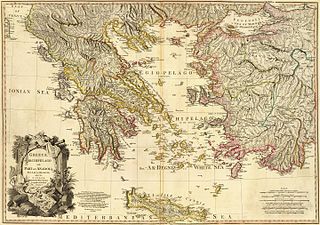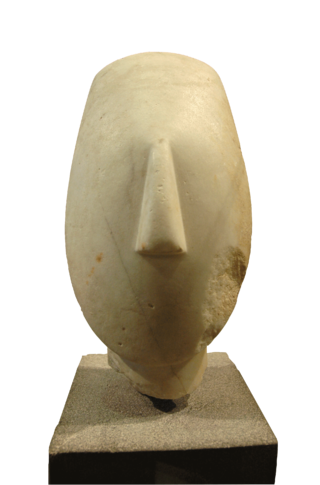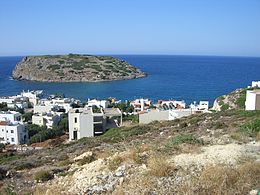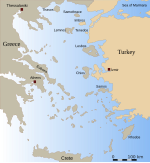
Aegean civilization is a general term for the Bronze Age civilizations of Greece around the Aegean Sea. There are three distinct but communicating and interacting geographic regions covered by this term: Crete, the Cyclades and the Greek mainland. Crete is associated with the Minoan civilization from the Early Bronze Age. The Cycladic civilization converges with the mainland during the Early Helladic ("Minyan") period and with Crete in the Middle Minoan period. From c. 1450 BC, the Greek Mycenaean civilization spreads to Crete, probably by military conquest. The earlier Aegean farming populations of Neolithic Greece brought agriculture westward into Europe before 5,000 BCE.

The Minoan civilization was a Bronze Age culture which was centered on the island of Crete. Known for its monumental architecture and energetic art, it is often regarded as the first civilization in Europe. The ruins of the Minoan palaces at Knossos and Phaistos are popular tourist attractions.

Knossos is a Bronze Age archaeological site in Crete. The site was a major center of the Minoan civilization and is known for its association with the Greek myth of Theseus and the minotaur. It is located on the outskirts of Heraklion, and remains a popular tourist destination. Knossos is considered by many to be the oldest city in Europe.

Gournia is the site of a Minoan palace complex in the Lasithi regional unit on the island of Crete, Greece. Its modern name originated from the many stone troughs that are at the site and its original name for the site is unknown. It was first permanently inhabited during the Early Minoan II periods and was occupied until the Late Minoan I period. Gournia is in a 6 mile cluster of with other Minoan archeological sites which includes Pachyammos, Vasiliki, Monasteraki, Vraika and Kavusi. The site of Pseira is close but slightly outside the cluster.

Zakros is a Minoan archaeological site on the eastern coast of Crete in Lasithi, Greece. It is regarded as one of the six Minoan palaces, and its protected harbor and strategic location made it an important commercial hub for trade to the east.

Spyridon Marinatos was a Greek archaeologist who specialised in the Bronze Age Minoan and Mycenaean civilizations. He is best known for the excavation of the Minoan site of Akrotiri on Santorini, which he conducted between 1967 and 1974. A recipient of several honours in Greece and abroad, he was considered one of the most important Greek archaeologists of his day.

Helladic chronology is a relative dating system used in archaeology and art history. It complements the Minoan chronology scheme devised by Sir Arthur Evans for the categorisation of Bronze Age artefacts from the Minoan civilization within a historical framework. Whereas Minoan chronology is specific to Crete, the cultural and geographical scope of Helladic chronology is confined to mainland Greece during the same timespan. Similarly, a Cycladic chronology system is used for artifacts found in the Aegean islands. Archaeological evidence has shown that, broadly, civilisation developed concurrently across the whole region and so the three schemes complement each other chronologically. They are grouped together as "Aegean" in terms such as Aegean art and, rather more controversially, Aegean civilization.

Aegean art is art that was created in the lands surrounding, and the islands within, the Aegean Sea during the Bronze Age, that is, until the 11th century BC, before Ancient Greek art. Because is it mostly found in the territory of modern Greece, it is sometimes called Greek Bronze Age art, though it includes not just the art of the Mycenaean Greeks, but also that of the Cycladic and Minoan cultures, which converged over time.

Pseira is an islet in the Gulf of Mirabello in northeastern Crete with the archaeological remains of Minoan and Mycenean civilisation.

The Minoan civilization produced a wide variety of richly decorated Minoan pottery. Its restless sequence of quirky maturing artistic styles reveals something of Minoan patrons' pleasure in novelty while they assist archaeologists in assigning relative dates to the strata of their sites. Pots that contained oils and ointments, exported from 18th century BC Crete, have been found at sites through the Aegean islands and mainland Greece, in Cyprus, along coastal Syria and in Egypt, showing the wide trading contacts of the Minoans.

Hagia Triada, is a Minoan archaeological site in Crete. The site includes the remains of an extensive settlement noted for its monumental NeoPalatial and PostPalatial period buildings especially the large Royal Villa. It is located in the Mesara Plain about three kilometers from the larger Palace of Phaistos, with which it appears to have had close political and economic ties. It is also nearby the Minoan harbor site of Kommos. Excavations at Hagia Triada have provided crucial evidence concerning Minoan everyday life.

Phourni is the archaeological site of an ancient Minoan cemetery in Crete, established in 2400 BC and lasted until 1200 BC. Phourni is Greek for "furnace, oven" and the name of the hill on which the cemetery is located. Phourni is located at 70100 Epano Archanes, Heraklion, Greece—located on a hill in north-central Crete. Phourni can be seen from Mount Juktas. It is a small hill situated northwest of Archanes, between Archanes and Kato Archanes. Phourni is reachable from a signed scenic path that starts at Archanes. It was an important site for Minoan burials. The burials consistently and proactively engaged the community of the Minoans. The largest cemetery in the Archanes area was discovered in 1957 and excavated for 25 years by Yiannis Sakellarakis, beginning in 1965. The 6600 sq m cemetery includes 26 funerary buildings of varying shapes and sizes. The necropolis of Phourni is of primary importance, both for the duration of its use and for the variety of its funerary monuments. All the pottery and much of the skeletal material was collected, unlike many other pre-palatial tombs. The cemetery was founded in the Ancient Minoan IIA, and continued to be used until the end of the Bronze Age. The occupation reached its peak during the Middle Minoan AI, just before the palaces of Knossos and Malia appeared. The proximity of Archanes to the important religious centres of Mount Iuktas probably contributed to the prominence of the site.

Kydonia, also known as Cydonia was an ancient city located at the site of present-day Chania on the island of Crete in Greece. The city is known from archaeological remains dating back to the Minoan era as well as literary and historical sources.

Minoan religion was the religion of the Bronze Age Minoan civilization of Crete. In the absence of readable texts from most of the period, modern scholars have reconstructed it almost totally on the basis of archaeological evidence such as Minoan paintings, statuettes, vessels for rituals and seals and rings. Minoan religion is considered to have been closely related to Near Eastern ancient religions, and its central deity is generally agreed to have been a goddess, although a number of deities are now generally thought to have been worshipped. Prominent Minoan sacred symbols include the bull and the horns of consecration, the labrys double-headed axe, and possibly the serpent.

Mycenaean pottery is the pottery tradition associated with the Mycenaean period in Ancient Greece. It encompassed a variety of styles and forms including the stirrup jar. The term "Mycenaean" comes from the site Mycenae, and was first applied by Heinrich Schliemann.

Minoan art is the art produced by the Bronze Age Aegean Minoan civilization from about 3000 to 1100 BC, though the most extensive and finest survivals come from approximately 2300 to 1400 BC. It forms part of the wider grouping of Aegean art, and in later periods came for a time to have a dominant influence over Cycladic art. Since wood and textiles have decomposed, the best-preserved surviving examples of Minoan art are its pottery, palace architecture, small sculptures in various materials, jewellery, metal vessels, and intricately-carved seals.

Phylakopi, located at the northern coast of the island of Milos, is one of the most important Bronze Age settlements in the Aegean and especially in the Cyclades. The importance of Phylakopi is in its continuity throughout the Bronze Age and because of this, it is the type-site for the investigation of several chronological periods of the Aegean Bronze Age.

Kavousi Vronda is an archaeological site in eastern Crete, Greece, located about 1.25 km south of the modern village of Kavousi, a historic village in the municipality of Ierapetra in the prefecture of Lasithi.
The Griffin Warrior Tomb is a Bronze Age shaft tomb dating to around 1450 BC, near the ancient city of Pylos in Greece. The grave was discovered by a research team sponsored by the University of Cincinnati and led by husband-and-wife archaeologists Jack L. Davis and Sharon Stocker. The tomb site was excavated from May to October 2015.
The archaeology of Greece includes artificial remains, geographical landscapes, architectural remains, and biofacts. The history of Greece as a country and region is believed to have begun roughly 1–2 million years ago when Homo erectus first colonized Europe. From the first colonization, Greek history follows a sequential pattern of development alike to the rest of Europe. Neolithic, Bronze, Iron and Classical Greece are highlights of the Greek archaeological record, with an array of archaeological finds relevant to these periods.























